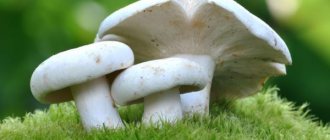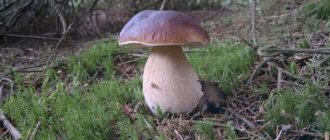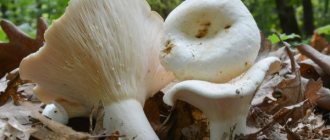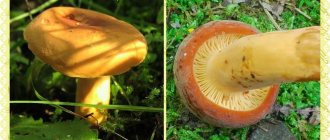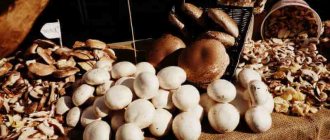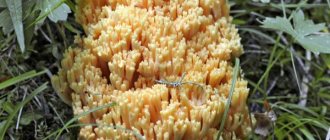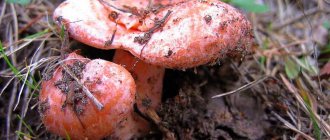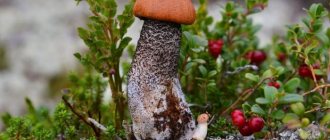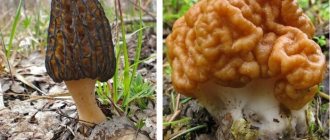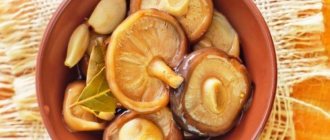The general name “goats” combines many tubular mushrooms from boletaceae, which belong to the fourth category in terms of their value. For some mushroom pickers, they are not of particular value, although their taste resembles boletus. Some types of these mushrooms have found their popularity in folk medicine. Our website does not provide any recommendations in this regard.
Goat mushrooms grow in the northern temperate zone of Russia, and they have many different names across regions. Among the most common are the cattail, mosshorn, fireweed and others. This article will analyze all the features of this mushroom, how to collect it, in what places it grows and how not to confuse it with inedible analogues.
Baby goat mushrooms.
Description of the mushroom
Kozlyaki are small edible mushrooms that grow in Russia throughout the northern temperate zone. The traditional name of the mushroom has many synonyms. In different regions, it has its own: reshetnik - because its lower part resembles a sieve, bolotnik (bolotovik) - because it grows in swamps, and other popular nicknames (horned grass, devil, mosshorn, mosswort, willowweed, sheepskin, mullein etc.). Externally, the kids resemble boletus, and some people mistakenly put them in the basket instead of boletus mushrooms. The color of the cap is really similar to the latter: yellowish or reddish-brown, red-brown, ocher. Its diameter usually reaches 4-12 cm. The skin is difficult to remove from the cap. It is smooth to the touch, but in damp weather it becomes covered with mucus.
The shape of the cap is cushion-shaped, convex or flat-convex, changing with age: it becomes flat or vague. The spores are yellow and smooth. Other characteristic features of a kid: The leg is 1-2 cm thick, up to 10 cm long. Matte, dense, cylindrical in shape, often curved and thickening downward. The colors of the stem and cap match. The pulp is elastic, in the stem it is red or brown, in the cap it is pale yellow, yellow. Turns pink when cut. Downsloping or weakly downsloping tubular layer. In young mushrooms it is gray-yellow, turns yellow as it grows, and becomes brown in color as it ages. The edges become torn. The class Agaricomycetes, order Boletaceae, belongs to the oilcan family.
The tubes (about 8 mm high) usually adhere to the stems and are difficult to separate from the flesh of the cap. If you taste the pulp, you can feel the sourness. The taste is usually inexpressive, but the smell is pleasant
The oiliness lasts for 1-2 days, but then dries out.
- Leg. The length of the leg usually reaches 10 cm, thickness - 1.5-2 cm. Its color from below can reach brown, and closer to the top it becomes noticeably light. If the leg is cut, it quickly turns red when cut.
- Tubes under the cap. The color of the tubes under the cap is initially yellow, then darkens over time. Their length reaches 10 mm. The tubular layer may sink slightly onto the stem and is difficult to separate from it.
- Spore powder. The spores are angular and large. The spore powder is olive-yellow in color, sometimes mixed with gray. The spores look like a small spindle.
- Pulp. This mushroom is elastic and springy, in no way loose. After cooking it acquires a purple tint. The mushroom does not have a pronounced mushroom smell, but it is immediately felt at the break.
Goat mushroom.
Features of primary processing
Before cooking goat mushroom, it must be properly processed. In rare cases, mushrooms become very dirty because they have dry caps. First, you need to soak them in clean water for five to ten minutes. If the kids are clean, then you can simply wash them a little.
Then you should eliminate all places where traces of parasites are found. It is recommended to cut the caps into pieces before use. Boil the mushrooms for fifteen to twenty minutes. After this procedure, the product is ready for subsequent preparation.
The cooking options here are similar to the preparation of other mushrooms belonging to the buttercup family. Accordingly, they can be salted, pickled, fried or boiled. For salting and pickling, it is recommended to use only young mushrooms, as they have strong and dense caps.
Spreading
People say: “Where there is a pine tree, there is a goat.” It is usually found in pine and spruce forests, but it also grows in swampy areas and likes acidic, moist soils. Willowweed can often be found in damp ravines. The mushroom does not grow alone; it can be found in groups, sometimes very numerous. Sometimes you can pick up a whole basket at once in one place.
Usually the goat appears within 1-2 days after the rain. At this time it needs to be collected. If you are late in collecting these mushrooms, up to 90% of them will already be wormy. You can find trellis almost everywhere, but it grows especially abundantly in central Russia, Belarus and northwestern Ukraine. There it is called “goat mushroom” and is especially readily collected. The goat is found in Siberia, the Far East, and the Urals.
They begin to collect it in early July and continue until September. In some regions, if warm autumn weather sets in, it can be found before frost, almost until November.
Reshetniki form mycorrhiza with pine, therefore they grow in coniferous forests, dry pine forests, on acidic poor soils, in damp places. They love areas along roads and swampy areas. Often, goat kids grow next to the rose weed (Gomphidus roseus), which parasitizes them. Nearby you can find cloudberries and blueberries - berries that prefer damp places.
Interesting on the topic: Boletus mushroom
Rich harvests of goats are harvested after heavy rain. They are found singly or in small groups. The ripening period for kids is from June to November. In most regions - in August and September. The distribution area of the trellis is quite wide. It grows: in Europe and on the European territory of Russia; in the North Caucasus; in Siberia; in the Far East; in the Urals.
Are kids raised?
Like other representatives of the Boletov family, kids can be raised at home. But baby goats are not suitable for further sale, because these mushrooms are not popular. It is recommended to plant a plantation only for personal consumption. How to grow trellis: Mycelium is planted in boxes filled with substrate at any time of the year, but it is advisable to do this from September to April-May, which will speed up the harvesting process. Pieces of mycelium are placed in holes made in boxes - there are from 10 to 15 of them - and covered with substrate. Over the winter months the mycelium will grow. In spring it is planted in the ground. You must first prepare the holes: mix the soil with wet sawdust. Holes for planting are dug near the coniferous tree.
Their diameter is about 10 cm, depth - 20 cm. Each hole with mycelium is slowly watered with a liter of water with lime (50 g per bucket) to disinfect the soil. The mycelium needs feeding. Plantings are covered with a layer of branches, moss, and leaves. On hot days, the soil around the holes must be moistened: once a week, 2-4 buckets of water are poured onto each tree. Although goat's rue cannot be called popular, these mushrooms have good taste and contain amino acids that are beneficial for humans. They are easy to find in the forest and can be identified with other mushrooms in appearance. The goats do not require additional soaking and are easy to prepare. They make good pickles and hot dishes (powdered soups, roasts with potatoes).
Where to collect goats.
Nutritional value and chemical composition
Although goat grass is significantly inferior to other similar types of mushrooms in terms of taste, it is a very useful plant that is well absorbed by the body. Thus, having a very low calorie content (only 20 kcal per 100 g), the kid contains a large amount of amino acids, carotene, phosphate, as well as vitamins B, D and PP, which are valuable for the human body.
Similar species
In many well-known sources, the goat mushroom is a synonym for the goat mushroom. But this is not correct from a scientific point of view, because the goat mushroom belongs to the genus Suillus from the family Boletaceae, and the goat mushroom is a species of the genus Xerocomus of the same family Boletaceae ( Latin Boletaceae). Therefore, these are two different generic branches of the same family of mushrooms, included in the general order of boletaceae, in one of which (in the genus of moss mushrooms) there are only edible mushrooms, and in the second (in the genus of butterflies) there are conditionally edible and even inedible species.
They differ in color, shape, and structure of the spore-bearing layer. In a kid, it is chocolate-colored, dense, finely porous; in the goat it looks like a large sieve with torn edges, olive-brown in color. Baby goat is a small fungus on a thin stalk, with a matte and smooth, porphyry (chocolate-brown) color cap and a leg of almost the same color with bright yellow flesh on the cut, which, moreover (unlike goat) is extremely rarely wormy. Therefore, the goat mushroom is perceived by mushroom pickers as a type of flywheel, and not an oiler, which includes the goat mushroom.
Interesting read: How to collect russula and at what time
In nature, the goat mushroom has one, very similar counterpart - it is an inedible pepper mushroom, which is considered such for the content of pungent substances in its pulp and, as a result, a very bitter taste. The goat itself is also a little bitter in taste and has mediocre taste characteristics (which cannot be said about the kid). That is why the goat was classified as a conditionally edible mushroom of the fourth category. However, many mushroom pickers consider it a completely edible mushroom and do not disdain it when collecting.
The main advantage of goat is that it contains a whole group of vitamins: vitamins B1, B2 and B3, vitamins D, PP (pantothenic acid), carotene, and also minerals, the main place among which is phosphorus. In addition, goat grass also has strong antibacterial properties, so it can be used for these purposes right in the forest, in cases of disinfecting possible wounds with bleeding.
Moss mushroom.
Evaluation of taste qualities, medicinal properties, benefits and possible harm
Butterfly is an edible mushroom, it is consumed fried, salted and pickled. Very often it is dried.
Reference! In folk medicine, goat is considered an effective remedy for the treatment of polyarthritis.
The goat mushroom, the benefits and harms of which will be discussed further, has not found widespread use in pharmaceuticals. Nevertheless, traditional healers claim that it has a number of medicinal properties:
- Improves vision. The mushroom contains selenium and polyunsaturated fatty acids, which prevent the occurrence of cataracts and retinal detachment.
- Slows down the aging of the body due to the presence of antioxidant substances. With regular but moderate use of lattice, the condition of the skin improves and sagging goes away.
- Relieves inflammation, normalizes lymph flow, water balance, helps in the treatment of sore throat, bronchitis.
- Activates the immune system, reducing the likelihood of developing seasonal viral diseases, especially during the peak of epidemics.
- Prevents the appearance of neoplasms, promotes the removal of harmful compounds, waste, and toxins from the body.
- Normalizes the functioning of the gastrointestinal tract due to the presence of dietary fiber, ash and water.
- Helps with weight loss, as it accelerates metabolic processes, removes toxins, and quickly satisfies the feeling of hunger.
Reference! It is believed that goat is most useful when salted, although drying also fully preserves the entire range of beneficial substances.
It must be remembered that the consumption of goat is prohibited for children under 9 years of age, pregnant and lactating women, people with pathologies of the kidneys, liver, and bile ducts. In addition, you need to know that the goat is very sensitive to radiation, and immediately absorbs toxins and poisonous substances from the air. Therefore, this species cannot be collected near industrial enterprises and roads.
Morphology (species differences)
Although many mushroom pickers know what goats look like, sometimes they are confused with other representatives of the Maslenkovs. They taste very similar, but differ in some appearance features and beneficial properties. The most striking difference is the change in the shape of the cap with age. In addition, the small size and favorite places of growth help to navigate the species of the fungus. Baby goats do not have a skirt on the leg, and the skin on the surface of the cap may peel off a little.
Differences between goat and others.
The flesh at the break becomes pinkish; other representatives of the Boletaceae order cannot boast of this. For example, this is what boletus looks like, well known to mushroom pickers and often used in cooking.
Note! In order not to confuse them with kids, it is worth remembering their large size and always slimy cap, which does not change shape with age.
Usage
Wild goat mushrooms are quite edible. They are consumed fresh and stored for future use. They are suitable for pickling, drying and freezing. When dried, the flesh of the mushrooms darkens. Dried goats make an excellent mushroom powder. When cooked (cooking and frying), they turn purple.
Undeservedly forgotten, but no less useful and tasty, goat mushrooms are found in almost every forest. Not every mushroom picker knows about their valuable properties and unpretentiousness to cooking conditions. But these representatives of the mycological kingdom are practically in no way inferior to their relatives, the boletus, and have a very “mushroom-like” attractive appearance.
How to collect
Reshetniks are not popular among mushroom pickers, but in the absence of other mushrooms they are also collected so that they do not return from the forest with an empty basket. They are record holders for worminess; sometimes out of the entire group there is not a single clean one. Having cut off the leg with a knife at the base, you need to take a closer look at it. Even if the stem is not wormy, the cap can be charged. At the slightest suspicion, you need to cut the cap to make sure and not take home a wormy mushroom. It’s better not to take old grates, because by the time the mushroom picker brings them home, they will deteriorate.
Application in medicine
Family of Goat Mushrooms
Research results prove that the flesh of Goat mushrooms inhibits the development of bacteria and various pathogenic microorganisms. Extract from raw mushroom is used to fight bacterial infections. A tincture of the skin and hymenophore is used to improve immunity. Compresses from fresh caps are used for joint inflammation, bruises, hematomas, as well as to increase blood circulation and relieve pain. Alcohol infusion is used for radiculitis, osteochondrosis and gout.
In folk medicine, goats have long been used to treat the heart, eyesight, anemia, diseases of the nervous system and the fight against cancer. The mushroom is also recommended to be consumed for weight loss, removing excess cholesterol, improving metabolism, preventing blood clots, and for overwork and depression.
An extract from the mushroom is used to treat purulent wounds and boils.
In cosmetology, an infusion of fresh goats is used as a lotion to treat skin diseases, relieve skin irritation and prevent flaking. Dried mushroom powder is included in masks for rejuvenation.
How to distinguish poisonous look-alikes from edible mushrooms?
There are no dangerous poisonous counterparts among species similar to kids. However, they can be confused with moss mushrooms, which require a slightly different cooking technique. They are distinguished by a greenish-brown cap and in most cases grow in a group. Inedible counterparts are presented in the form of a pepper mushroom. It is considered harmless, but has an unusually pungent, unpleasant taste. After cooking for a long time, it can be converted into a spice.
They can be distinguished from false trellises by their lighter color, without red or brown impurities. In addition, inedible varieties do not reach large sizes and are more often found in deciduous forests, which are unsuitable for kids.
How to distinguish mushrooms.
Goats and boletus
The kids belong to the genus Suillus bovinus or the Boletaceae family. This also includes the well-known and beloved boletus. Some mushroom pickers perceive baby goats as simply a type of butter. They are often confused with them, since in appearance the kids are very reminiscent of them. They also look like flywheels. Goat kids have many names. In different areas they are called differently - mire mushroom, goat mushroom, lattice mushroom, cow mushroom, lamb mushroom, lamb mushroom, dry oiler, fireweed, and sub-walnut mushroom.
Drying goats
Drying baby goat mushrooms
The collected specimens of mushrooms, after sorting and cleaning from forest debris, need to be wiped dry with a rag. There is no point in washing them, since Kozlyaks do not dry out very well. The cap must be cut and checked for the presence of worms - they often eat the inside of the cap, without signs of any external damage. In sunny weather, mushrooms can be dried by stringing them on a thread. If weather conditions do not allow, then the goats are dried in the oven at a temperature of 70 degrees, with the door ajar. After drying, the smell of mushrooms intensifies. If you grind dried Kozlyaki in a coffee grinder, you can get a wonderful powdered seasoning, suitable for seasoning sauces, meat and rice dishes.
